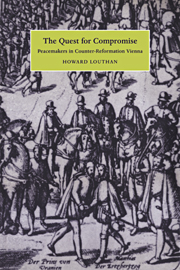Book contents
- Frontmatter
- Contents
- List of illustrations
- Acknowledgments
- A political and cultural chronology
- List of abbreviations
- Introduction
- PART I THE EMERGENCE OF AN IRENIC COURT
- 1 From confrontation to conciliation: the conversion of Lazarus von Schwendi
- 2 Jacopo Strada and the transformation of the imperial court
- PART II MAXIMILIAN II AND THE HIGH POINT OF IRENICISM
- PART III THE FAILURE OF IRENICISM
- Conclusion: Storm clouds on the horizon: from the great milk war to the Thirty Years War
- Epilogue: The wider circle of irenicism
- Select bibliography
- Index
- CAMBRIDGE STUDIES IN EARLY MODERN HISTORY
1 - From confrontation to conciliation: the conversion of Lazarus von Schwendi
Published online by Cambridge University Press: 03 December 2009
- Frontmatter
- Contents
- List of illustrations
- Acknowledgments
- A political and cultural chronology
- List of abbreviations
- Introduction
- PART I THE EMERGENCE OF AN IRENIC COURT
- 1 From confrontation to conciliation: the conversion of Lazarus von Schwendi
- 2 Jacopo Strada and the transformation of the imperial court
- PART II MAXIMILIAN II AND THE HIGH POINT OF IRENICISM
- PART III THE FAILURE OF IRENICISM
- Conclusion: Storm clouds on the horizon: from the great milk war to the Thirty Years War
- Epilogue: The wider circle of irenicism
- Select bibliography
- Index
- CAMBRIDGE STUDIES IN EARLY MODERN HISTORY
Summary
It was the often caustic Voltaire who penned the famous line, “This agglomeration which was called and which still calls itself the Holy Roman Empire is neither holy, nor Roman, nor an Empire.” Voltaire's aphorism has become a tired but popular cliché to the great annoyance of scholars who study this area of central Europe. Many who have cast a hurried glance at the complex bundle of imperial territories have wondered what inner logic kept this decentralized polity functioning for so long in a viable fashion. Thought by many a living anachronism, the Empire confounded its critics as it creaked forward through time displaying a remarkable ability to redefine itself for each new generation. It weathered a whole series of crises that often brought civil war or dynastic struggle to other European states.
Our discussion of irenicism begins in one such period of crisis – years of political uncertainty when the Habsburg princes once more sought a new source of unity for the Empire and its estates. The decade 1545 to 1555 was particularly crucial for the emperor. This period began with the Habsburg triumph of the Schmalkaldic War when there seemed to be one last opportunity to reimpose a uniform religious and political settlement on the imperial lands. The Augsburg Interim of 1548 was Charles's final attempt to unite Catholic and Protestant. At the same time he also sought to establish a new confederation of German estates that would serve the Habsburgs as the Swabian League had done in the past. Both projects failed. The 1555 Peace of Augsburg at least temporarily acknowledged the strength of German particularism and the reality of a divided confessional polity.
- Type
- Chapter
- Information
- The Quest for CompromisePeacemakers in Counter-Reformation Vienna, pp. 13 - 23Publisher: Cambridge University PressPrint publication year: 1997



